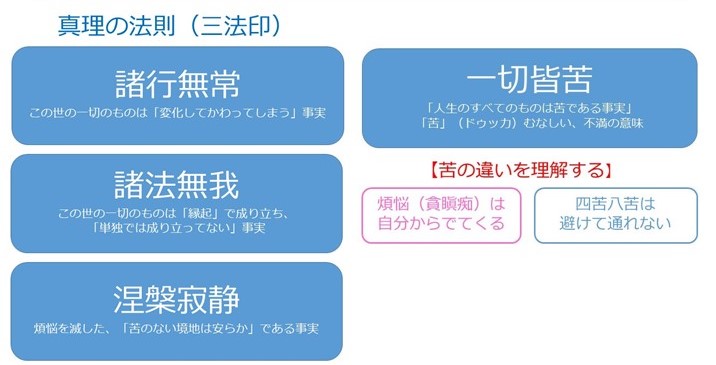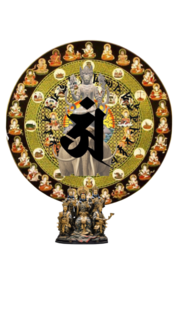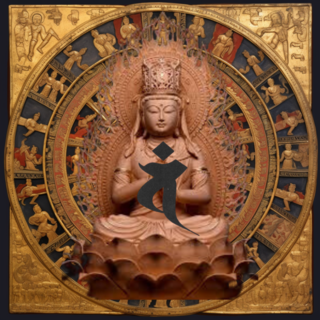�l�O�Z
�l�_���@�i�������ق��j
�l�@�ӑ��Ƃ��B
�l�̎��ݗ͂邽�߂̍����ƂȂ���́B�����R�I�Ȑ_�ʗ͂邽�߂̂S��w�~�_���i�悭�����j�E�ΐ_���i�����j�E�S�_���i�����j�E�ϐ_���i�����j�x�̏C�s�@�B
�S�� ����
4 �̗ᕶ (0.00 �b)
- �������O�́A�O�\�����i�̂Ȃ����l�O�Z�Ȃǂɂ�����O�Ƃ���悤�ɁA��{�T�O�̈�ł���B
- �l�O�Z�E�l���f�E�l�_���E�܍��E�ܗ́E���o�x�E�������̎��Ȃɕ������B
�l�O���̓��e�͈ȉ��̒ʂ�[1]�B
- �g�O���i�g�O�Z�j - �g�̂̕s����ς���i�s����j
- ��O���i��O�Z�j - ��̎�͋�ł���Ɗς���i��؊F���j
- �S�O���i�S�O�Z�j - �S�̖�����ς���i���s�����j
- �@�O���i�@�O�Z�j - ���@����������i���@�����j
�l�O���i���˂�j�E�l�O�Z�i���˂イ�j
�u�l�O���E���˂�v�́i�����ȍ~�̐V��������ł́u�l�O�Z�E���˂イ�j�Ƃ��Ă�܂��B
�^���Ƃ͐^�t�̊Ԉ�����l�����́A�l�^�|�i���Ă�ǂ��j��
�u��y���v�i���傤�炭�����傤�j��Ŕj�����ґz�ł��B
����̂܂܂Ɏ������ώ@�����ґz�ŁA
�C�Â����ґz�A�ώ@�����ґz�A���B�p�b�T�i�[�ґz�̂��ƂɂȂ�܂��B
���́A�l�O�����ґz�́A�o�T�̒��ł́A
�u�g��S�@�v�i���サ��ق��j�̋����ŁA
�u�b�_�̐��@���悭�łĂ��܂��B
���ɁA�g��S�@�����Ă����܂��傤�B
�g��S�@�i���サ��ق��j
�E�g�O���i����˂�j�E�g�O�Z�i����˂イ�j
�u�g�̂ɂ��āv���炾���悭�ώ@�����āA
�u�g�͕̂s��v�ł��邱�Ƃ��݂�i�C�Â��j�ґz�ł��B
����́A�u�s��ρv�i�ӂ��傤����j�ƕ\������Ă��āA
�����̐g�̂͌��]�i������j���琬�藧���݂ŁA
�g�̂ŐڐG���Ċ�����̂��ׂāA
�͂��Ȃ��u��؊F��v�i���������������j�̔ϔY�ɂȂ邱�Ƃ��A
�ώ@���ґz�����ē��@���Ă����܂��B
���̎����̐g�̂̌��i�������j�u�ځA���A�@�A��A�g�́v��@���Ɋώ@���܂��B
![���]�i������j](https://buddha.pink/wp-content/uploads/2019/08/z18-10.jpg)
�E��O�� �i����˂�j�E��O�Z�i����˂イ�j
�u����ɂ��āv�A������悭�ώ@���āA
�u����͋�v�ł��邱�Ƃ��݂�i�C�Â��j�ґz�ł��B
����́A
���]�Ő��藧�����̊���u��v�i����j��@���Ɋώ@���Ă����܂��B
������̂͂��ׂāA�u���E�s���E�ǂ���ł��Ȃ��v�̂R�p�^�[���̂��Âꂩ�Ŕ��f���Ċ��܂��B
�u�ڂŌ�����́A���ŕ������́A�@�Śk�����́A��Ŗ��키���́A�g�̂ŐG�����́A������Ŋ����邱�Ɓv���ׂāu���E�s���E�ǂ���ł��Ȃ��v��3�p�^�[�����Âꂩ�Ŋ��āA���ׂĂ͂��Ȃ��u��v�ɂȂ邱�Ƃ��ώ@���܂��B
���̎����̌��i�������j�u�ځA���A�@�A��A�g�́v�Ŋ��邱�Ƃ�@���Ɋώ@���܂��B
�E�S�O�� �i����˂�j�E�S�O�Z�i����˂イ�j
�u�S�ɂ��āv�A�S���悭�ώ@���āA
�u�S�͖���v�ł��邱�Ƃ��݂�i�C�Â��j�ґz�ł��B
����́A
���]�Ő��藧�����̍l�������`�����Ă����u�s�v�i���傤�j�͏�ɕω�������̂ł���u���s����v�i���催�傤�ނ��傤�j�ł���Ɣ@���Ɋώ@���܂��B
���̎����̐S��@���Ɋώ@���܂��B
�o�T�ł́A
�Â�̂���S���u�킽���̐S���Â�������Ă���v�ƒm��B
�Â�𗣂ꂽ�S���u�킽���̐S���Â�𗣂ꂽ�v�ƒm��B
�{��̂���S���u�킽���͓{��̐S�������Ă���v�ƒm��B
�{��𗣂ꂽ�S���u�킽���͓{��̐S�𗣂ꂽ�v�ƒm��B
�ƕ\������Ă��܂��B
�E�@�O�� �i�ق��˂�j�E�@�O�Z�i�ق��˂イ�j
�u�������̎��ہE�@�ɂ��āv�A
�������̎��ہE�@���悭�ώ@���āA
�u�����镨���͖���v�ł��邱�Ƃ��݂�i�C�Â��j�ґz�ł��B
����́A
�O�@��i����ڂ�����j�́u���@����v�i����ق��ނ��j��@���Ɋώ@���邱�Ƃł��B

�o�T�ł̕\���̂��ꂩ��
�l�O���E�l�O�Z�́u�g��S�@�v�͌��n���T�ɂ́A
�u�悭�C��t���A
�M�S�ɐ��������o���A
���������ĉ߂����A
���Ԃ��Â�J�����������ׂ��v
�ƂłĂ��܂��B
�u�O�v�i�˂�j�̓p�[����ŃT�e�B�isati�j��
�@�L���i�������j����B
�A�S���U���ɂȂ����肵�Ȃ��悤�ɒ��ӗ͂𑣂��B
�B�l�O���i�T�e�B�p�b�^�|�i�j�̏�ɖ���E��E�����O���ɒu��
�̈Ӗ�������܂��B
�ځ[����
���́u�g��S�@�v���ґz�ł́A�܂��u��v���A�z���C�����́u�z�v�� ���݂��Ă���F�E���ґz�ł��B����z���Ȃ����n���u�z��Łv�ł���ɂ����Ə���ґz�̋��n�ł��B
���Ȃ݂ɁA�u�g�v�̂��炾�͗~�]���x�z����~�E�̐��E�ŁA
�g�̗̂~�]���Ȃ����������ȕ����̐F�E�̐��E�Łu��v���ώ@���Ă����ґz�ł��B
�i�Q�l�j�F�u�O�E�v�i�����j�։鐢�E
�l�^�|�i���Ă�ǂ��j
�u�b�_�������u�^���v�̎O�@��́A
���ʂ̐l�X�ɂ݂͂��Ȃ��āA�킩��Ȃ��̂ŁA
���ʂ̐l�X�͂܂������t�̂��Ƃ��v���ē��X�߂����Đ����Ă���l�����A�l�^�|�i���Ă�ǂ��j�́A�l�̐^����������Č����Ă��鋳���ł��B
���̎l�̐^�����A�u��y���v�ɂȂ�܂��B
��y���i���傤�炭�����傤�j
�l�͖���ł���̂ɁA�u��ł���v�Ƃ݂āA
��ɖ������ӂ�Ă���̂ɁA�u�y�ł���v�Ƃ݂āA
���N�i���j�ƌ��]�i������j�Ő��肽����̎����Ȃ̂ɁA�u���䂪����v�Ƃ݂�
�s��i�ӂ��傤�j�Ȃ��Ƃ��A�u���炩�ł���v�Ƃ݂ĉ߂����Ă��܂��B
������u��y���v�i���傤�炭�����傤�j�ƌ����āA
�u�b�_�������u�^���v�Ƃ́A�܂������������܂Ȏl�̌��������āA
�ꂵ�݂̐��E�ɐ����Ă���̂��킽�����������ʂ̐l�Ԃ̋����ɂȂ�܂��B
�ځ[����
��敧���ł́u��y���v�i���傤�炭�����傤�j�͟��ς̋��n��\�����Ӗ��ŗp�����邱�Ƃ�����܂��B
���ς̊o��̓��͐�̉i���̏�ł���A
�y���݂ł���A
�\���I�Ȏ��ݎ҂̉�ł���A
����炩�ȏ�ł���A
�l�̓��ŁA�l���i���Ƃ��j�ƌĂ�܂��B
�������A
�O�@��𗝉����Ă��Ȃ��܂܂��ƁA
�l�^�|�ɂȂ�̂Œ��ӂ��K�v�ł��ˁB
���n���T�ɂłĂ���u�l�O���E���˂�v
�����o�T�@��Q�o�u����ʌo�v�i��������傤�j�ł�
�u���E���E��̉����̋����v���u���o�튯�̖h��v���s���ӗ́E���ĂȈӎ��t�̊ώ@�����ґz�̋������łĂ��܂��B�����āA���u�����v���u�܊W�̏����v���u�F�E�̎l�T�v���u����̓��@�v���u�_�ʗ͂āv���u�R�s�q�v�̔ϔY�����ł��āw�l���x�𗝉�����ƂłĂ��܂��B
�s���ӗ́E���ĂȈӎ��t
�u�b�^�͏C�s�҂͂ǂ�ȍs������Ƃ������ĂȈӎ��������čs�����܂��B�߂𒅂�Ƃ����A�������Ƃ����A�H�ׂ�Ƃ����A���ނƂ����A�r�ւ���Ƃ����ǂ�Ȏ������������������Ă���̂��𖾗ĂȈӎ������o���čs�����g�ɂ��Ă��܂��B
�ځ[����
�ґz�Ƃ����Ɠ�����ł����A�e���r�����Ȃ���A�X�}�z�������Ȃ���Ƃ��ł͂Ȃ��A�����̍s�����ӎ��������čs�����Ƃł��ˁI
�����o�T�@��2�Q�o�u��O���o�v�i�����˂カ�傤�j�ł�
�u�g�̂ɂ��āi�g�͕̂s��j�v
�E���E�сE���E���E��E���E�E���E�����E�t���E�S���E���t�E���ցA���X�����̍ו��܂ł��ώ@����
�E�n���Ε��̗v�f���ώ@����
�E���̂��ґz�A���Ɏ̂Ă�ꂽ���̂��J���X�⌢�ɐH�ׂ�ꕅ���Ă����̂��ώ@����
�u���o�ɂ��āi����͋�j�v
�E�y���݁A�ꂵ�݁A����̓I�̊����N�����ł���̂��ώ@����
�u�S�ɂ��āi�S�͖���j�v
�E�Â�A�{��A���ρA�S�̓���A�L��ȐS�����N�����ł���̂��ώ@����
�u�������̑��݁i���ہE�@�j�ɂ��āi�����镨���͖���j�v
�E�܊W�ɂ��āA���N�Ə��ł��ώ@����
�E�Z���̑����̐��N�Ə��ł��ώ@����
�u�ċz�̎d���v��
���O���邱�Ƃ�ڂ̑O�ɐ����č���A�C��t���Ȃ��瑧���z���A����f���A
���g�̂̊�����Â߂āA���͑���f�����Ǝv�����C����B
�������̓��ɁA���l�̊O�̐g�̂ɂ��Ċώ@�A�g�̂̒��Ő��N���Ă�����́A
���ł��錻�ۂ��ώ@����B
�������u�g�݂̂̂����݂���v�Ǝv���A�ˑ����Ȃ��A�������Ȃ��Ȃ�B
�ƕ\������ĂłĂ��܂��B
����V
�˂��A�ځ[����I�ŏ����ґz������Ȃɓ���́A�A�A�B
�ځ[����
����V�́A���ѐH�I���������A�ĂԂ���ɂ��Ă�̂��C�Â��Ȃ�����ˁA�A�A�B�ł����v����I�u�b�_�͂�������ґz�̋����������Ă���Ă��邩��ˁI�ґz�̎��H��C�s���e��������Ă��邨�o���Љ�܂��ˁI
�u���ĂȈӎ��v�Ŋώ@���ґz���łĂ��遫
Satipatthana
Iddhipada method
Translated as Iddhipada.
The basis for obtaining four free powers. Four types of training methods for obtaining supernatural mythical power: greed gods, gonjinsoku, shinjinsoku, and kanjinsoku.
All nouns
4 example sentences (0.00 seconds)
The correct idea is one of the basic concepts, as is the case with Satipatthana in the thirty-seven dojos. ...
It is divided into seven departments: Satipatthana, Four Right Exertions, Iddhipada, Indriya, Five Strengths, Seven Factors of Awakening, and Noble Eightfold Path. ...
The contents of Satipatthana are as follows [1].
Satipatthana (Satipatthana) --Seeing the uncleanness of the body (Uncleanness)
Satipatthana (Satipatthana) --I see that all vedan is painful (everyone is suffering)
Satipatthana (Mindful residence) -Watching the unchanging mind (Unusual behavior)
Satipatthana (Law Satipatthana)-Seeing the selflessness of various laws (lawlessness)
Satipatthana, Satipatthana
"Satipatthana / Shinenjo" is also called (in the new Chinese translation after Xuanzang, "Satipatthana / Shinenju").
The wrong way of thinking, which is the exact opposite of the truth, of the four defeats
It is a meditation that breaks down "Jorakugajo".
In meditation to observe yourself as you are
It's about awareness meditation, observing meditation, and Vipassana meditation.
This meditation of Satipatthana is in the scriptures.
With the teaching of "Shinjushinho"
Buddha's preaching often comes up.
Next, let's look at the self-reliance method.
Self-reliance method (Shinjushinho)
�E Satipatthana �E Satipatthana
"About the body" Observe the body closely and
It is a meditation to see (notice) that the body is unclean.
This is described as "Patikulamanasikara".
My body is made up of five skandhas,
Everything that you feel in contact with your body
To be annoyed by the ephemeral "everyone suffers"
We will meditate on observation and gain insight.
Observe the five senses of your body, "eyes, ears, nose, tongue, and body."
�E Satipatthana (Junenjo) �E Satipatthana (Junenju)
"About the feeling", observe the feeling closely,
It is a meditation to see (notice) that "sensation is painful".
is this,
I will observe the "Uke" (ju) that I feel, which is made up of five skandhas.
Everything you feel is judged by one of the three patterns of "pleasant, unpleasant, and neither".
"What you see with your eyes, what you hear with your ears, what you sniff with your nose, what you taste with your tongue, what you touch with your body, and what you feel with your heart" are all "pleasant, unpleasant, neither" Observe that everything becomes ephemeral "bitter".
Observe what you feel with your five senses, "eyes, ears, nose, tongue, and body."
�E Satipatthana �E Shinnenju
"About the mind", observe the mind closely,
It is a meditation to see (notice) that "the mind is impermanent".
is this,
I clearly observe that the "line" that forms one's own way of thinking, which consists of five skandhas, is the "various lines" that are constantly changing.
Observe that one's heart.
In the scriptures
Knowing a greedy heart, "My heart has greed."
Knowing that the heart that has left greed is "my heart has left greed."
Know that an angry heart is "I have an angry heart."
Knowing that the heart that has left anger is "I have left the heart of anger."
It is expressed as.
�E Satipatthana �E Honenju
"About various events and laws",
Observe various events and methods carefully,
It is a meditation to see (notice) that "every substance is selfless".
is this,
It is to observe the "Shohomuga" of Sanboin.
How to express in the scripture
Satipatthana and Satipatthana's "Self-reliance method" is described in the Early Buddhist scriptures.
"Be careful,
Be enthusiastic and correct
Stay calm,
We should overcome the greed of the world. "
Will come out.
"Nen" is a Pali word for sati
�@ Remember (teach).
�A Encourage your attention so that you do not get distracted.
�B Always keep in mind the impermanence, suffering, and selflessness of Satipatthana.
There is a meaning of.
Bo-san
This "self-reliance method" meditation is a meditation in the color world where both "reception" and "thought" of feelings still exist. The state of meditation that is neither received nor thought is the state of meditation that is even higher.
By the way, the body of the "body" is in the world of desire that controls desire,
It is a meditation that observes "Uke" in the world of pure material color world that has lost the desire of the body.
(Reference): "Three worlds" (Sangai) The world that revolves around
Four defeats
The three methods of "truth" that Buddha saw are
Because it is invisible to ordinary people and does not understand
The idea that ordinary people spend their days living thinking the exact opposite is the teaching of the four truths of the four truths.
The four truths are "Joraku Gajo".
Joraku Gajo
People are impermanent, but they think they are "always"
Even though it is full of pain, I think it is "easy"
Even though I am a selfless self made up of auspiciousness and five gods, I think that I have an ego.
I spend my time thinking that unclean things are "clean."
This is called "Jorakugajo".
The "truth" that Buddha saw is from four completely upside-down perspectives.
Living in the world of suffering is the teaching of ordinary human beings.
Bo-san
In Mahayana Buddhism, "Jorakugajo" is sometimes used to mean the state of Nirvana.
The virtue of Nirvana's awakening is an absolute eternal everlasting
I'm looking forward to it
I am an active freelancer
It is a clean purification,
The four virtues are called Shitoku.
But,
If you don't understand the Dharmamudrā
You need to be careful because it will be a mess.
"Satipatthana, Shinenjo" that appears in the primitive Buddhist texts
In the second sutra "Samon Kakyo"
"Teaching of small, medium and large commandments"-> "Protection of sensory organs"-> "Attention / clear consciousness" will give you the meditation teachings to observe. Then, �� "Satisfaction" �� "Removal of the five lids" �� "Four Zens of the Color World" �� "Insight of Selflessness" �� "Getting Mythical Power" �� "Four Noble Truths" disappears It will come out when you understand.
<< Attention / Clear Consciousness >>
Buddha acts with a clear consciousness when the practitioner does anything. He is aware of what he is doing now, when he wears clothes, when he holds a bowl, when he eats, when he drinks, when he defecates, and when he acts and wears it. I am.
Bo-san
Meditation is difficult, but it's not about watching TV and touching your smartphone, but consciously doing what you do!
In the Nagabe scripture, the 22nd sutra, "Dainenjukyo"
"About the body (the body is unclean)"
�E Observe your own details such as hair, hair, blood, teeth, skin, flesh, muscles, bones, bone marrow, kidneys, heart, blood, urine, etc.
�E Observe the elements of groundwater, fire and wind
�E Meditation of corpses, observing crows and dogs eating and rotting corpses abandoned in the graveyard
"About the senses (feeling is painful)"
�E Observe that enjoyment, suffering, and non-physical sensations occur and disappear.
"About the mind (the mind is impermanent)"
Observe greed, anger, delusion, unity of mind, and the emergence and disappearance of a vast mind
"About the existence (events / laws) of various things (all substances are selfless)"
�E Observe the occurrence and disappearance of the five hindrances
�E Observe the occurrence and disappearance of the bondage of the six senses
"How to breathe"
�� Sit with your thoughts in front of you, take care while inhaling and exhaling,
�� Calm down my physical activity and practice with the intention of exhaling.
�� Observing the body inside and outside of others, what happens inside the body,
Observe the disappearing phenomenon.
�� I just think that "only the body exists", there is no dependence, and there is no attachment.
It will be expressed as.
Enbo
Hey, Bo-san! The first meditation is so difficult ...
Bo-san
Enbo doesn't even notice the rice mash on his face after he finishes eating. But it's okay! Buddha teaches me meditation properly! Introducing the sutras that describe the practice of meditation and the content of training!
Observation meditation comes out with "clear consciousness" ��
�y���̃J�e�S���[�̍ŐV�L���z
-
no image
-
no image






